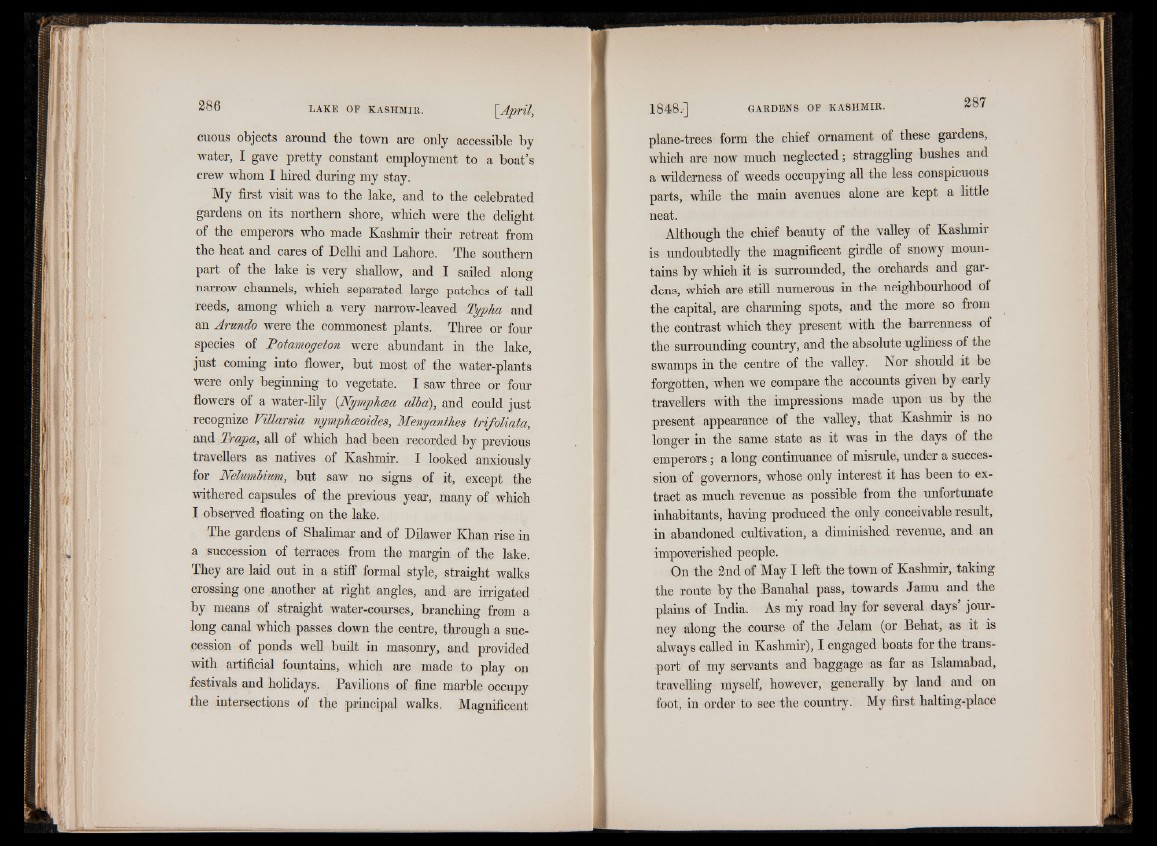
cuous objects around the town are only accessible by
water, I gave pretty constant employment to a boat’s
crew whom I hired during my stay.
My first visit was to the lake, and to the celebrated
gardens on its northern shore, which were the delight
of the emperors who made Kashmir their retreat from
the heat and cares of Delhi and Lahore. The southern
part of the lake is very shallow, and I sailed along
narrow channels, which separated large patches of tall
reeds, among which a very narrow-leaved Typha and
an Arundo were the commonest plants. Three or four
species of Potamoyeton were abundant in the lake,
just coming into flower, but most of the water-plants
were only beginning to vegetate. I saw three or four
flowers of a water-lily (NympTicea alba), and could just
recognize Villarsia nymplceoides, Menyanthes trifoliata,
and Trap a, all of which had been recorded by previous
travellers as natives of Kashmir. I looked anxiously
for Nelumbium, but saw no signs of it, except the
withered capsules of the previous year, many of which
I observed floating on the lake.
The gardens of Shalimar and of Dilawer Khan rise in
a succession of terraces from the margin of the lake.
They are laid out in a stiff formal style, straight walks
crossing one another at right angles, and are irrigated
by means of straight water-courses, branching from a
long canal which passes down the centre, through a succession
of ponds well built in masonry, and provided
with artificial fountains, which are made to play on
festivals and holidays. Pavilions of fine marble occupy
the intersections of the principal walks. Magnificent
plane-trees form the chief ornament of these gardens,
which are now much neglected; straggling bushes and
a wilderness of weeds occupying all the less conspicuous
parts, while the main avenues alone are kept a little
neat.
Although the chief beauty of the valley of Kashmir
is undoubtedly the magnificent girdle of snowy mountains
by which it is surrounded, the orchards and gardens,
which are still numerous in the neighbourhood of
the capital, are charming spots, and the more so from
the contrast which they present with the barrenness of
the surrounding country, and the absolute ugliness of the
swamps in the centre of the valley. Nor should it be
forgotten, when we compare the accounts given by early
travellers with the impressions made upon us by the
present appearance of the valley, that Kashmir is no
longer in the same state as it was in the days of the
emperors; a long continuance of misrule, under a succession
of governors, whose only interest it has been to extract
as much revenue as possible from the unfortunate
inhabitants, having produced the only conceivable result,
in abandoned cultivation, a diminished revenue, and an
impoverished people.
On the 2nd of May I left the town of Kashmir, taking
the route by the Banahal pass, towards Jamu and the
plains of India. As my road lay for several days’ journey
along the course of the Jelam (or Behat, as it is
always called in Kashmir), I engaged boats for the transport
of my servants and baggage as far as Islamabad,
travelling myself, however, generally by land and on
foot, in order to see the country. My first halting-place